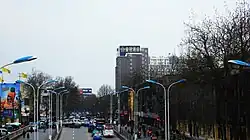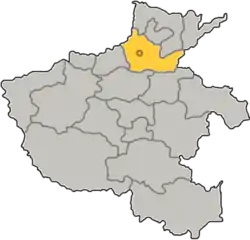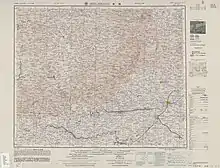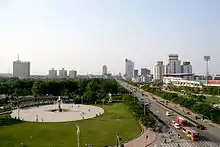Xinxiang
新乡市 Sinsiang | |
|---|---|
 | |
 Xinxiang's location in Henan province | |
 Xinxiang Location on the North China Plain  Xinxiang Xinxiang (China) | |
| Coordinates (Xinxiang municipal government): 35°18′13″N 113°55′36″E / 35.3036°N 113.9268°E | |
| Country | People's Republic of China |
| Province | Henan |
| Municipal seat | Hongqi District |
| Government | |
| • Party Chief | Li Weidong(李卫东) |
| • Mayor | Wei Jianping(魏建平) |
| Area | |
| • Prefecture-level city | 8,629 km2 (3,332 sq mi) |
| • Urban | 431 km2 (166 sq mi) |
| • Metro | 3,390 km2 (1,310 sq mi) |
| Population (2020 census for total, 2018 otherwise)[2] | |
| • Prefecture-level city | 6,251,929 |
| • Density | 720/km2 (1,900/sq mi) |
| • Urban | 1,179,400 |
| • Urban density | 2,700/km2 (7,100/sq mi) |
| • Metro | 2,743,200 |
| • Metro density | 810/km2 (2,100/sq mi) |
| Time zone | UTC+8 (China Standard) |
| Area code | 0373 |
| ISO 3166 code | CN-HA-07 |
| GDP | ¥238.48 billion (2017) |
| Major Nationalities | Han |
| County-level divisions | 12 |
| License plate prefixes | 豫G |
| Website | www |
Xinxiang (simplified Chinese: 新乡; traditional Chinese: 新鄉; pinyin: Xīnxiāng [ɕín.ɕjáŋ]; postal: Sinsiang) is a prefecture-level city in northern Henan province, China.
It borders the provincial capital of Zhengzhou to its southwest, Kaifeng to its southeast, Hebi and Anyang to its north, Jiaozuo to its west, and the provinces of Shanxi and Shandong to its northwest and east respectively.
Its total population was 6,251,929 as of the 2020 Chinese Census. As of the 2018 estimation, 2,743,200 lived in the built-up (or metro) area made of 4 urban districts (Weibin, Hongqi, Muye, Fenquan), Yanjin county, Xinxiang county and Huixian City which are now being conurbated as the city is expanding very quickly.[2]
History
Xinxiang was site of the Battle of Muye where the Shang Dynasty was overthrown by the Zhou. Xinxiang dates from the Sui dynasty (581-618) and was a small market center before being developed as an industrial center in the 1950s. It also served as the capital of the short-lived Pingyuan Province, which covered neighbouring cities -Anyang, Hebi, Puyang, Jiaozuo and Heze, between 1949 and 1952, for the purpose of pacifying Nationalist guerillas through military action and accepting surrender.
In July 2021, Xinxiang was harshly impacted by the flooding in Henan, which affected about 470,000 people and over 55,000 hectares (140,000 acres) of cropland.[3]
Geography
Climate
| Climate data for Xinxiang (1991–2020 normals, extremes 1981–2010) | |||||||||||||
|---|---|---|---|---|---|---|---|---|---|---|---|---|---|
| Month | Jan | Feb | Mar | Apr | May | Jun | Jul | Aug | Sep | Oct | Nov | Dec | Year |
| Record high °C (°F) | 18.9 (66.0) |
24.8 (76.6) |
29.0 (84.2) |
36.1 (97.0) |
38.0 (100.4) |
40.9 (105.6) |
40.5 (104.9) |
37.7 (99.9) |
36.8 (98.2) |
34.3 (93.7) |
27.7 (81.9) |
23.9 (75.0) |
40.9 (105.6) |
| Mean daily maximum °C (°F) | 5.5 (41.9) |
9.6 (49.3) |
15.5 (59.9) |
22.1 (71.8) |
27.4 (81.3) |
32.1 (89.8) |
32.1 (89.8) |
30.8 (87.4) |
27.0 (80.6) |
21.6 (70.9) |
13.8 (56.8) |
7.4 (45.3) |
20.4 (68.7) |
| Daily mean °C (°F) | 0.3 (32.5) |
3.9 (39.0) |
9.9 (49.8) |
16.3 (61.3) |
21.9 (71.4) |
26.5 (79.7) |
27.6 (81.7) |
26.3 (79.3) |
21.8 (71.2) |
15.8 (60.4) |
8.2 (46.8) |
2.2 (36.0) |
15.1 (59.1) |
| Mean daily minimum °C (°F) | −3.7 (25.3) |
−0.6 (30.9) |
4.8 (40.6) |
10.8 (51.4) |
16.5 (61.7) |
21.1 (70.0) |
23.7 (74.7) |
22.6 (72.7) |
17.5 (63.5) |
11.1 (52.0) |
3.8 (38.8) |
−1.9 (28.6) |
10.5 (50.8) |
| Record low °C (°F) | −13.9 (7.0) |
−16.0 (3.2) |
−6.2 (20.8) |
−0.7 (30.7) |
7.6 (45.7) |
12.4 (54.3) |
17.2 (63.0) |
13.5 (56.3) |
7.5 (45.5) |
−0.9 (30.4) |
−12.8 (9.0) |
−11.5 (11.3) |
−16.0 (3.2) |
| Average precipitation mm (inches) | 5.6 (0.22) |
8.8 (0.35) |
14.1 (0.56) |
31.1 (1.22) |
42.6 (1.68) |
66.4 (2.61) |
163.5 (6.44) |
120.2 (4.73) |
62.2 (2.45) |
29.1 (1.15) |
20.0 (0.79) |
4.7 (0.19) |
568.3 (22.39) |
| Average precipitation days (≥ 0.1 mm) | 2.6 | 3.7 | 3.9 | 5.1 | 6.5 | 7.6 | 11.1 | 10.1 | 7.5 | 5.8 | 4.5 | 2.3 | 70.7 |
| Average snowy days | 3.3 | 3.1 | 1.1 | 0.2 | 0 | 0 | 0 | 0 | 0 | 0 | 1.2 | 2.1 | 11 |
| Average relative humidity (%) | 59 | 57 | 55 | 59 | 60 | 61 | 76 | 78 | 73 | 68 | 67 | 61 | 65 |
| Mean monthly sunshine hours | 116.5 | 138.4 | 182.4 | 211.2 | 234.2 | 210.6 | 182.2 | 184.5 | 166.7 | 162.5 | 140.5 | 129.2 | 2,058.9 |
| Percent possible sunshine | 37 | 45 | 49 | 54 | 54 | 49 | 41 | 45 | 45 | 47 | 46 | 43 | 46 |
| Source: China Meteorological Administration[4][5] | |||||||||||||
Pollution
According to a 2015 report by Greenpeace, Henan (Xinxiang's province) has the most severe air pollution of all the provinces in China, with an average PM2.5 concentration of 103.3 μg/m3 (micrograms per cubic meter).[6] The report found that Xinxiang has the 13th most polluted city air in China, with a PM2.5 concentration of 114.6 μg/m3 (over 11 times the safe limit established by the WHO) during the first quarter of 2015. Swiss firm IQAir reported that Xinxiang suffered from an average PM2.5 concentration of 51.5 μg/m3 in 2020, ranking 31st in China,[7] and 89th in the world.[8]
In 2015, environmental non-governmental organization Airman (Chinese: 好空气保卫侠) purchased wheat samples farmed in the town of Wangcun, in Xinxiang, near a battery factory, and found it had cadmium levels up to 17 times the national safe limit.[9] The following year, the group again purchased wheat samples in the towns of Dakuai and Wangcun,[10] and found cadmium levels up to 34.1 times the national safe limit.[9][11][12] Following this report, the Xinxiang municipal government launched a program to purchase contaminated wheat, and convert the farmland to other purposes.[9] However, again in 2017, the group purchased additional wheat samples, and found them to have cadmium levels up to 18 times the national limit, with all samples purchased exceeding national safety limits.[9] In response, government officials from the town of Dakuai met with the group, and pledged to further investigate the samples and stop growing wheat on contaminated farmland.
Religion
Xinjiang Roman Catholics are served by the Apostolic Prefecture of Xinxiang (Latin: Sinsiang / Sinsiangen(sis)), which was established on July 7, 1936, on missionary territory split off from the then Apostolic Vicariate of Weihuifu (simplified Chinese: 卫辉府; traditional Chinese: 衛輝府) (now Diocese of Jixian). It is a pre-diocesan jurisdiction, which is exempt (i.e., directly subject to the Holy See and its missionary Roman Congregation for the Evangelization of Peoples), and not part of any ecclesiastical province.
It has had the following incumbent Apostolic Prefects of Xinxiang (Roman Rite) :
- Father Thomas Megan (米干), Divine Word Missionaries S.V.D.) (born USA) (1936.07.07 – retired 1948), died 1951
- Fr. Johannes Schütte (舒德), S.V.D. (born Germany) (1948 – death 1971.11.18), also Superior General of Society of the Divine Word (Divine Word Missionaries) (1958.03.28 – 1967.12.15) and Vice-Secretary of Pontifical Commission of Justice and Peace (1968–1971.11.18)
- Joseph Zhang Wei-zhu (張維柱) (first Chinese and secular priest) (1992, with clandestine episcopal consecration)
Military
Xinxiang is the headquarters of the 83rd Group Army of the People's Liberation Army, one of the three group armies that comprise the Jinan Military Region responsible for defence of the Yellow River plain.
Administration

The prefecture-level city administers 4 districts, 3 county-level cities and 5 counties.
- District:
- County-level city:
- County:
| Map |
|---|
Economy
Frestech, a major home appliance company, was located in Xinxiang prior to its liquidation in 2018. One of the business units spun off in Frestech's dissolution, Xinfei Electric Group, continues to operate in Xinxiang.[13] Xinfei Electric Group, now a wholly-owned subsidy of Aviation Industry Corporation of China, produces refrigerated trucks, military vehicles, RVs, modular building structures, precision equipment, refrigerators, air conditioners, and environmental control equipment.[13]
Other important enterprises located in Xinxiang include Golden Dragon Copper Group, Bailu Chemical Fibre, Henan Kelong Group, and AVIC XINHANG Industry Corporation.
Agriculture and textiles
Textiles and processed food are also major products of Xinxiang. As an old textiles base, the cotton industry is very developed in Xinxiang.
Transport

The city is a rail junction and industrial centre at the head of navigation on the Wei River. The river, made navigable for small vessels by river improvements in the 1950s, links the city with Tianjin, the main port for Beijing. Later, due to heavy industrial chemical pollution, the river course had been totally cut off and got filled up. After recent dredges, it is still no more than a man-made lake.
Rail
Xinxiang is located at the junction of the Beijing-Guangzhou, Xinxiang-Yueshan and the Xinxiang-Yanzhou Railways.
Xinxiang has two railway stations: Xinxiang Railway Station and Xinxiang East Railway Station.
Education and research
Xinxiang is a major city for research appearing among the top 200 cities in the world by scientific research outputs as of 2023, as tracked by the Nature Index.[14]
There are several universities and colleges located in the prefecture-level city.[15]
- Henan Normal University
- Xinxiang University: newly combined university located in the eastern part of Xinxiang, it has 21 faculties and 3 centers
- Henan Institute of Science and Technology
- Xinxiang Medical University
- Henan Mechanical and Electrical Engineering College
- Xinxiang Hygiene School
Sister city
See also
References
- ↑ 最新人口信息 www.hongheiku.com (in Chinese). hongheiku. Retrieved 2021-01-12.
- 1 2 "China: Hénán (Prefectures, Cities, Districts and Counties) - Population Statistics, Charts and Map". citypopulation.de. Retrieved 2021-11-26.
- ↑ "Flood toll rises in central China, as tens of thousands evacuated". www.aljazeera.com. 2021-07-22. Archived from the original on 2021-08-12. Retrieved 2021-08-11.
- ↑ 中国气象数据网 – WeatherBk Data (in Simplified Chinese). China Meteorological Administration. Retrieved 12 August 2023.
- ↑ 中国气象数据网 (in Simplified Chinese). China Meteorological Administration. Retrieved 12 August 2023.
- ↑ Boren, Zach (2015-04-20). "China launches biggest ever smog monitoring drive — and what the data tells us". Greenpeace. Archived from the original on 2021-08-05. Retrieved 2021-08-11.
- ↑ "World's Most Polluted Cities in 2020 - PM2.5 Ranking". IQAir. Archived from the original on 2021-03-21. Retrieved 2021-08-11.
- ↑ "World's Most Polluted Cities in 2020 - PM2.5 Ranking". IQAir. Archived from the original on 2021-08-12. Retrieved 2021-08-11.
- 1 2 3 4 2017年麦收河南新乡随机抽取12个麦样,全是“镉麦”. goufenxiang.cn (in Chinese). 2017-06-30. Archived from the original on 2021-08-14. Retrieved 2021-08-14.
- ↑ Yuan, Suwen; Li, Rongde (2017-08-15). "Battery Factory Boom Leaves Toxic Legacy". Caixin. Archived from the original on 2021-08-14. Retrieved 2021-08-14.
- ↑ 河南牧野环保局回应“镉麦”:政府已经全数收购 (in Chinese). Caixin. 2016-08-30. Archived from the original on 2021-08-14. Retrieved 2021-08-14.
- ↑ Zhou, Tailai (2016-08-30). "NGO questions Xinxiang's claim it bought all cadmium-laced wheat". Caixin. Archived from the original on 2018-07-02. Retrieved 2021-08-11.
- 1 2 集团概况 [Group overview]. www.xinfeijituan.com (in Chinese). Archived from the original on 2021-08-12. Retrieved 2021-08-11.
- ↑ "Leading 200 science cities | Nature Index 2023 Science Cities | Supplements | Nature Index". www.nature.com. Retrieved 2023-11-22.
- ↑ S.L.U, Course Guru. "All Universities in Xinxiang". UniversityGuru. Retrieved 2023-11-22.
Sources and external links
- Government website of Xinxiang Archived 2008-09-26 at the Wayback Machine (in Chinese)
- GCatholic - apostolic prefecture
- Window on Xinxiang (in Chinese and English)
- Xinxiang University (in Chinese)

